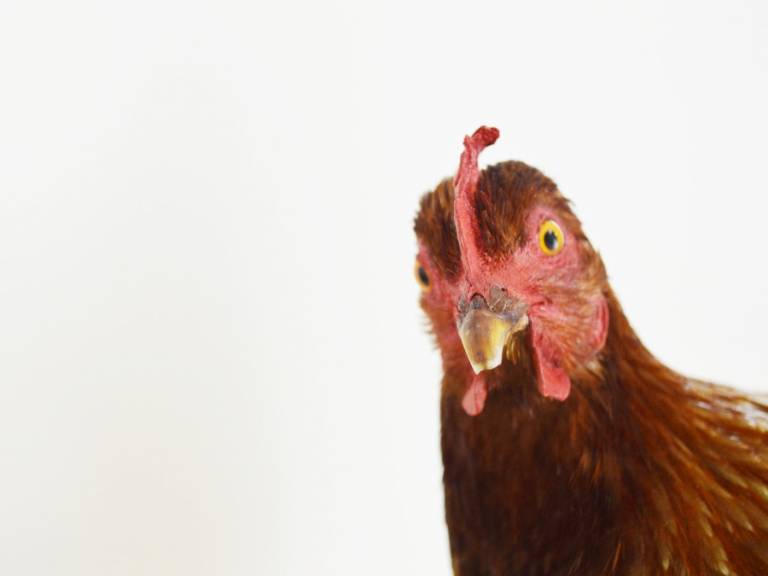The Museum of Ordinary Animals opens at UCL Grant Museum of Zoology
10 October 2017
The Museum of Ordinary Animals, an exhibition celebrating the mundane creatures in our lives including dogs, cats, cows and chickens and their role in shaping human endeavours, has opened at the UCL Grant Museum of Zoology.

While natural history museums are usually known for exhibiting strange or unusual animals such as dinosaurs and dodos, the focus of The Museum of Ordinary Animals is on the domestic.
Jack Ashby, Manager of the UCL Grant Museum, explains, "There are a few animals that get all the limelight - dinosaurs, and dodos and big whales are all the rage at the moment - the other animals that are much more mundane and boring and part of our everyday lives don't tend to show up in museum galleries."
"We've come up with The Museum of Ordinary Animals to right that wrong and give them a chance to tell their stories."
Like all exhibitions at the UCL Grant Museum, the exhibition is based on research taking place at UCL.
"We're talking about cats and dogs, mice and rats, chickens and pigeons, rabbits and cows - animals that are either domesticated or are a really significant part of human lives. What have we learnt from them? Have they affected us? How have we changed them? How do they fit into society? What role do they play in science? And what is their impact on the environment?"
The specimens of the museum sit comfortably alongside the more extraordinary objects that the UCL Grant Museum is more traditionally known for, such as a jar of moles, its collection of brains, or the extremely rare quagga skeleton (a type of extinct South African Zebra) - one of only seven existing in the world.
The Museum of Ordinary Animals collects research from a wide variety of sources at UCL, including the UCL Institute of Education, UCL Genetics, Evolution & Environment and UCL Pathology. Prints are featured from the UCL Art Museum.
There are four themes to the exhibition. These are: "Creating Ordinary Animals", "Ordinary Animals in Culture", "Ordinary Animals in Science", and "Ordinary Animals in the Environment". Each part focuses on a different facet of the interaction of Ordinary Animals and the human and natural worlds.
Among the specimens featured in "Creating Ordinary Animals" are the skulls of domestic dogs. Even though there is one species of dog, Ashby explains that "humans have forced the dog to be the anatomically most variable of all species". Different breeds display different anatomical characteristics, which the exhibition strives to show.
There is also a taxidermy chicken, commissioned by the Museum. It was put together by ethical taxidermist Jazmine Miles-Long, and came from a free-range poultry rescue farm in Brighton after the chicken had died of natural causes. Specimens of domestic chickens are rare in museums, perhaps owing to their abundance outside of them. A connected research piece by Professor Mark Thomas (UCL Genetics, Evolution & Environment) explains how our understanding of chicken domestication owes itself to archaeology, theology, genetics and evolution.
"Ordinary Animals in Culture" features two cat mummies, on loan from the UCL Petrie Museum of Egyptian Archaeology. Here, the cultural and religious significance of cats in Ancient Egypt is explained. Near them sit what may be the world's oldest veterinary text - a 4,000 year old papyrus instructing the reader how to look after cattle.
In "Ordinary Animals in Science", the exhibition displays the key role of Ordinary Animals in helping to understand the world around us and ourselves. The cases feature three "fancy pigeons" on loan from The University Museum of Zoology, Cambridge, similar to those that inspired Charles Darwin's theory of evolution. There is also a research piece on guppy fish by Professor Judith Mank (UCL Genetics, Evolution & Environment), showing that female guppies with small brains made worse decisions when it came to mates. Research by UCL Anthropology PhD student Katrina Holland demonstrates how dogs are helping create medical breakthroughs by detecting prostate cancer in the urine of patients.
The final part of the exhibition focuses on "Ordinary Animals in the Environment", and the effect that domesticated animals have had when they have been introduced into the wild.
The re-introduction of these species has, in most instances, been destructive. Research by UCL's Professor Tim Blackburn shows that invasive species like cats and rats and dogs and pigs have contributed to more vertebrate extinctions than any other cause - more than climate change, more than habitat loss, more than pollution.
The exhibition finishes with stories of how we have sought to control species that are seen as pests - a 4,000 year old rat catcher, a modern story on the controversial badger cull, and a print, "The Rat Catcher", from the UCL Art Museum.
Ashby hopes that the exhibition will shine a new light on the instrumental role Ordinary Animals have had in human life. It will be complemented by a programme of events, including lunchtime talks, a discussion event and a late opening evening. Full details are provided in the links below.
The Museum of Ordinary Animals runs until 22 December 2017. It provides a fascinating insight into humans' involvement with the natural world, how we have shaped it, and how it has shaped us in turn.
Links
Image
- Taxidermy chicken (Credit: UCL Grant Museum of Zoology; Jazmine Miles-Long)
Media contact
Jacinta Mulders
Tel: +44 (0)20 3108 6496
Email: j.mulders [at] ucl.ac.uk
 Close
Close

